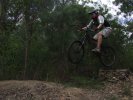You are hereForums / By Discipline / Mountain (off road) / By Location / Australia / NSW / NSW Trail Advocacy / NSW NPWS Sustainable Mountain Biking Strategy
NSW NPWS Sustainable Mountain Biking Strategy
NB: Originally posted elsewhere on the Global Riders Network and appears via syndication.
Heads up... NSW NPWS have released their Sustainable Mountain Biking Strategy, check it out here:
- Login to post comments
- Bookmark & share
Tags


Thanks for posting!
Had a chat and interview with ABC Radio this morning about it, took me by surprise that it was out today. Got to say I hate doing radio interviews.
Pretty happy with the policy as a whole.
A very very good day for Mountain biking in National Parks, thanks to everyone involved in helping this this become a reality thus far!
After a quick look, found the following interesting:
1.5 Strategic approach
Generally speaking the predominant unofficial single trails that pop up in National Parks are downhill or descending, unless they provide suitable and sustainable downhill or Gravity style trails(where there is a clear need), illegal construction will continue, its a no brainer.
NPWS with the help of GTA put in a cross country/AM trail, however unofficial DH trails are still popping up.
http://www.rotorburn.com/forums/showthread.php?2...
Thanks to Sammydog from GTA they are now in talks with NPWS to implement a descending(Gravity trail) into the park
http://glenrocktrailalliance.com/node/31427
http://glenrocktrailalliance.com/node/31542
The point is, this situation will be repeated over and over again unless descending trails or gravity trails are discussed on a case by case basis for suitability within the POM
Whether it be advantageous to implement Gravity straight away or down the track as Glenrock have done, it should be looked at on a case by case basis as every area/Park is different.
This is good it leaves the door open to Downhill possibilities
Whilst most of the above can be seen as true, I dont agree with this description of downhill, its written with negative connotations and half truths, something a little more positive and respectfull is needed.
All in all the policy is great for mountain biking, but needs tweaking just a little to really work and stop unofficial trail construction
Love the NPWS signs in: Appendix VI: Signage
Ben, just to be clear because you seem to have the Glenrock story a bit mixed up with your posts around the place. DH is not suddenly back on the table because of that one illegal trail that was constructed. The DH discussion has never gone away, we have been talking since day one with the NPWS about the need for replacement DH trails. The corridor we have got support to use as a technical descending trail was originally flagged by NPWS a few years back. Its just taken until recently to really resolve some issues.
I do agree with your point on the need for the trails to be provided. I've been banging on about the burning social need for the trails with Councils, NPWS and SF for years. If they aren't provided yes they will be built. The burning question is what land tenure is best for them.
To be brutally honest with you, I am yet to see a DH trail (and I'm thinking back to when I used to do the State and National Series events) that is sustainable to the point of being suitable for most of the NP's I visit. This is one thing that hurts us. Even Awaba that is maintained heavily scares NPWS with some of the erosion in sections. We are using power easements to solve the problem in glenrock and I think its a workable compromise. Will riders see it that way, time will tell.
I have no doubt in the future we will see more adventurous trails appear in NP lands, we just need to be patient and build up to them. start small scale and build up. Thats how we went from band aid repairs in glenrock to wholesale closures and reroutes of trails. Start small, build trust and work up to it.
Honestly, while I don't agree entirely with not providing the trails, I can completely see the NPWS position.
Looking at the policy, I whole heartedly agree with this
I think you need to stop being hung up with the term DH, just lobby for technical descending AM trails and design in a return climb. Thats essentially where we are at with the Glenrock process. The trail will be no less technical that the existing DH trails (probably more so), but it won't be called a DH trail.
Yes, understand you guys have been onto it for years, and we all appreciate it. And from what i understand you started advocacy at Glenrock with DH as your motivation, it just seems recent events brought it back into the limelight, and my point was that this will be repeated if DH/Gravity/Tech decending trails are not provided where there is a local need.
From my post above:
As you can see im with you on the tech decending/am/gravity trails.
I too agree with that quote about DH, however more maintainence does not make a trail unsustainable, it just needs more TLC, of which volunteers as you know are only too happy totake care of.
I think we all have to be carefull of not mixing up:
Self-sustaining (Able to sustain itself independently)
Sustainable (the capacity to endure)
No trail will ever be self sustaining, unless its a natural cow trail meandering along a river bank
Thredbo DH, its sustainable been there for years, no major environmental disasters have occured due to DH trail being there
http://youtu.be/eLmrJPLS4vQ
Also this might be just the answer for NPWS
Copperhead @ MT buller is also one to keep an eye on
http://youtu.be/ZeFM6rxKniA
The Decending side of Stonelfly is not bad either
http://youtu.be/ZcDfCmiQnIU